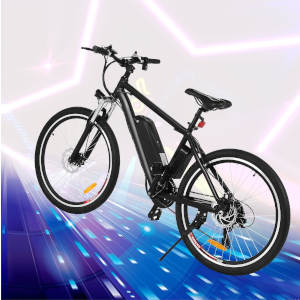 Thinking to invest on an E-Bike? Wondering how fast a 1000w Electric Bike goes? Continue reading to find the answer!
Thinking to invest on an E-Bike? Wondering how fast a 1000w Electric Bike goes? Continue reading to find the answer!
Every year people spend thousands of dollars on fuel. If you are trying to save cash, then the fuel expenses alone can take a huge chunk out of your pockets. Fortunately, nowadays we have the option to purchase an Electric Bike for our daily commute. They have a battery that charges with pedalling so there are no additional fuel expenses.
One common question that people often have is: how fast can an E-Bike really go? Can it meet their daily commute requirements? This is why, to provide a deeper insight on this subject, we will discuss everything you need to know about E-Bikes and how fast can a 1000w Electric Bike go.
Pros
- Utilizing an E-Bike is a great way to get some exercise.
- Offers a range of classes to help find the perfect bike which meets the requirements of the rider.
- It will prove to be a source of cheap transportation for you in the long run.
- It will enable you to spend more time outdoors with your friends and family.
- An electric bike will allow a rider to travel further than they normally would on a regular bicycle without exerting the same amount of energy.
Cons
- Electric bikes are heavier than conventional E-Bikes which might be a problem when you’re transporting the E-Bike from one place to another.
- Electric bikes might require more specialized and complex parts which might not be easily available in the market. So, if your E-Bike needs repairing find the necessary parts might be a hassle.
How Fast Does a 1000w E-Bike go?
 It is needless to say that the motor of a 1000W E-bike is FAST. It might surprise you but a 1000W E-Bike has the potential to go at more than 36.3 miles per hour! Having a 470 RPM motor, even if it sounds low a 1000W E-Bike is a total beast. Although, we do not recommend traveling at such a high speed, and you even may get fined for it. But for reference, we hope you now understand what a 1000W E-Bike is capable of.
It is needless to say that the motor of a 1000W E-bike is FAST. It might surprise you but a 1000W E-Bike has the potential to go at more than 36.3 miles per hour! Having a 470 RPM motor, even if it sounds low a 1000W E-Bike is a total beast. Although, we do not recommend traveling at such a high speed, and you even may get fined for it. But for reference, we hope you now understand what a 1000W E-Bike is capable of.
To properly understand how fast a 1000W E-Bike goes, knowing what goes behind the scenes is also essential. This is why, from the battery capacity, to classes, range and motor info let’s have a look at all of it.
Three Main Classes of E-bikes
There are three main classes of E-Bikes: class 1, class 2 and class 3 respectively. Each class focuses on its unique set of features and helps to determine the speed limit. Many countries around the globe have adopted this classification of electric bikes as a means to implement and follow necessary bike regulations to ensure safety.
Class 1:
Once you start pedalling the class 1 E-Bike will start assisting you. It will stop once you have reached 20 miles an hour. Furthermore, this bike will aid you with pedalling, but not your throttle.
Class 2:
In the biking community, the class 2 E-Bikes are commonly known as the “low-speed throttle-assisted electric bicycle”. Despite them having a limit of 20 miles per hour, you can still attain a higher speed by pedalling with the motor turned off.
Class 3:
The E-Bikes of class 3 are slightly more aerodynamic and faster when compared to the bikes of the other two classes. Class 3 E-Bikes are usually known as “speed pedal-assisted electric bicycles” as they help the rider while pedaling. Also, class 3 E-Bikes have a speed limit of up to 32 miles per hour and are equipped with a speedometer.
Speed Info: Motor
People who are new in the e-biking industry often make mistakes when they try to figure out which power rating would suit them the most. They focus way too much on the specifics, such as watts and voltage. This is due to the wide spread misconception which is higher the watts, the faster the bicycle will be. Instead, it is necessary to understand that a high number of watts don’t mean more speed rather it means higher power.
Also, it is important to mention that the faster you go on your E-Bike, the more energy you will use. So, if you’re riding at a high speed and are barely pedaling then you will drain your battery more quickly.
To figure out which power rating would be most suitable for a rider, it is obligatory to calculate the rider’s weight and whether the hills he/she will be climbing are decent sized or not. Obviously, if the weight of the rider is heavy then more power is required to operate the E-Bike. The same logic can be applied onto the size of the hills. The steeper the hills, the more wattage will be needed.
For instance, if a woman with a weight of 70 kilos wants to utilize her electric bike to climb extremely steep and long hills then an E-Bike with high wattage will be required, ideally a 750 watts electric bike would do the job perfectly.
Battery Capacity & Electric Bike Range
The majority of the latest electric bikes use lithium-ion batteries. One of the ways of measuring energy capacity is with watt-hours and it can be evaluated easily by simply multiplying the voltage by the amp hours of the battery pack. For instance, if it’s a 10-ah battery pack with 36-volts then (36×10=360) which means you will get up to 18 miles with your 360 watt-hour pack.
The range you’ll be able to travel on an electric bike, as well as the weight and cost can be determined with the help of watt-hours. These are salient aspects you should look into before purchasing an E-Bike. It is important to keep in mind in some instances you will have to sacrifice weight for power.
Conclusion
The world’s your oyster when you want to travel around on an E-Bike. It helps you climb stiff hills, it frees you up and gives you full control to set your own pace with pedal power and with the assistance of gravity and the wind behind your back it helps make adventurous trips a pleasurable experience.



